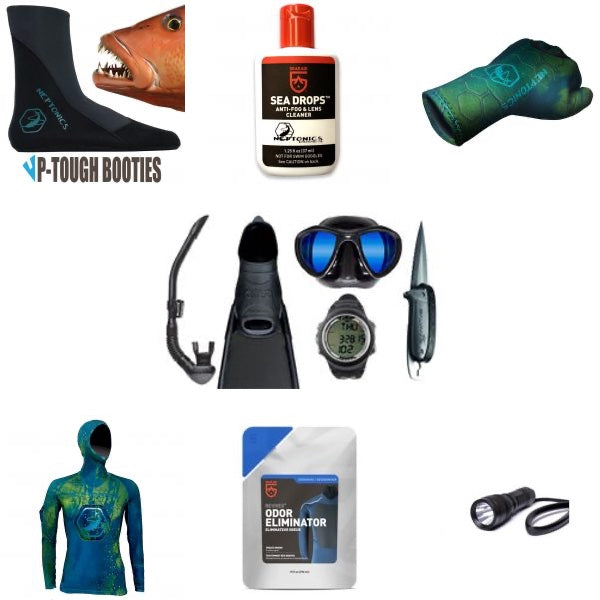
Freediving and Spearfishing Gear - Basics
Freediving and Spearfishing Gear Basics
Gear Basics
As with any hobby, freediving offers a wide range of gear options available on the market. All of that gear can make shopping a real headache for beginners! For spearfishing in particular, there are a lot of different kinds of guns, lines, rigging, shafts, reels, floats, knives, etc that can be very overwhleming to sort through. In this article, we will cover a few basic pieces of gear you will need to get started.
Masks & Snorkels
In order to see underwater you will need a mask. Freediving masks tend to be low in volume, which means the mask has as little extra area as possible inside of it to reduce the amount of air between it and your face. As you dive underwater you need to exhale into your mask to keep it from squeezing against your face. The lower the volume the mask, the less you will need to exhale into it as you dive. Other than the volume consideration, the other main concern is to find a mask that seals and is comfortable on your face. You don't have to mess around much with different lens types when you first start out, just find a clear-lensed mask that fits you well.
Snorkels are needed to comfortably breathe at the surface while keeping your face in the water. Freediving snorkels come in two varieties. The J snorkel is simple as it gets. They are just silicone rubber tubes that allow you to breathe. If they get water in them, you have to push the water out with a strong exhale. The fact that they are essentially just tubes means they can fill with water and just as easily be straws as snorkels in rough seas. Some divers prefer snorkels like the Riffe Stable Snorkel because it is designed to prevent water entry and it has a purge valve that drains any water that does get into the snorkel.
Fins & Booties
Freediving fins come in three broad categories and each have their own benefits. There is a separate post on this blog comparing and going in depth on all the different types of fins. Plastic fins are durable and cost effective. Composite fiberglass fins are more efficient in the water, but tend to cost more. Carbon fiber fins are most efficient, but most costly. All free dive fins are longer than snorkeling or scuba fins. They usually have a foot pocket that encloses the heel which means it is most comfortable when worn with a neoprene sock, often called a bootie. They differ from scuba fins that have an open heel with a strap.
Wetsuits, Weight Belts, and Knives
Freediving wetsuits tend to come in two parts, usually sold together. Most freediving wetsuits are open-cell wetsuits, which keep the water completely out. This helps keep the diver warmer than closed-cell wetsuits, but can be more difficult to put on without proper preparation. Freediving suits just need to be wet or lubricated to get into them easily. Wetsuits help keep divers warm, but they are also helpful in keeping divers buoyant and preventing abrasion from the natural environment.To counter the buoyancy of the wetsuit, you will need to use a weight belt and weights. You still need to be able to float at the surface but you want to be able to rest on the bottom, or whatever depth you are hunting, without constantly kicking down. You will need to adjust the amount of weight on your belt to your diving style, but a good rule of thumb is to wear enough to sink after 30 feet of depth, but float on the surface.
All divers need to carry a dive knife with them. There are countless entanglement hazards underwater, and you need a knife to effectively deal with them. Most divers keep these knives on their belt or on straps on their legs. Keep in mind that a knife strapped to the leg may become an additional entanglement hazard when fighting a fish with a reelgun.
